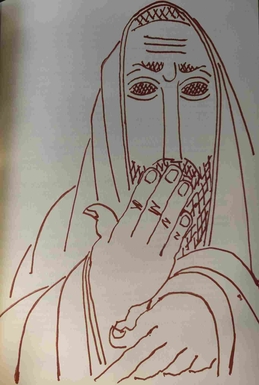Related Research Articles

The exilarch was the leader of the Jewish community in Persian Mesopotamia during the era of the Parthians, Sasanians and Abbasid Caliphate up until the Mongol invasion of Baghdad in 1258 CE, with intermittent gaps due to ongoing political developments. The exilarch was regarded by the Jewish community as the royal heir of the House of David and held a place of prominence as both a rabbinical authority and as a noble within the Persian court. Within the Sasanian Empire, the exilarch was the political equivalent of the Catholicos of the Christian Church of the East, and was thus responsible for community-specific organizational tasks such as running the rabbinical courts, collecting taxes from Jewish communities, supervising and providing financing for the Talmudic academies in Babylonia, and the charitable re-distribution and financial assistance to needy members of the exile community. The position of exilarch was hereditary, held in continuity by a family that traced its patrilineal descent from antiquity stemming from king David.

Hai ben Sherira better known as Hai Gaon, was a medieval Jewish theologian, rabbi and scholar who served as Gaon of the Talmudic academy of Pumbedita during the early 11th century. He was born in 939 and died on March 28, 1038. He received his Talmudic education from his father, Sherira ben Hanina, and in early life acted as his assistant in teaching. In his forty-fourth year he became associated with his father as "av bet din," and with him delivered many joint decisions. According to Sefer HaKabbalah of Rabbi Abraham ben David (Ravad), he was the last of the Geonim.

Amram Gaon was a gaon or head of the Academy of Sura in Jewish Babylonia in the ninth century.
Geonim were the presidents of the two great Babylonian Talmudic Academies of Sura and Pumbedita, in the Abbasid Caliphate. They were generally accepted as the spiritual leaders of the Jewish community worldwide in the early medieval era, in contrast to the Resh Galuta (exilarch) who wielded secular authority over the Jews in Islamic lands.
Sherira bar Hanina more commonly known as Sherira Gaon was the gaon of the Academy of Pumbeditha. He was one of the most prominent Geonim of his period, and the father of Hai Gaon, who succeeded him as Gaon. He wrote the Iggeret Rav Sherira Gaon, a comprehensive history of the composition of the Talmud.
Bostanai, also transliterated as Bustenai or Bustnay, was the first Exilarch under Arab rule. He lived in the early-to-middle of the 7th century, and died about 660 CE. The name is Aramaized from the Persian bustan or bostan, meaning "Garden". Bostanai is the only Dark Age Babylonian Exilarch of whom anything more than a footnote is known. He is frequently made the subject of Jewish legends.
Rabbah bar Naḥmani was a Jewish Talmudist known throughout the Talmud simply as Rabbah. He was a third-generation amora who lived in Sassanian Babylonia.
Abba ben Joseph bar Ḥama, who is exclusively referred to in the Talmud by the name Rava, was a Babylonian rabbi who belonged to the fourth generation of amoraim. He is known for his debates with Abaye, and is one of the most often cited rabbis in the Talmud.

Simeon ben Gamliel (I) (Hebrew: שמעון בן גמליאל or רשב"ג הראשון; c. 10 BC – 70 AD) was a Tanna sage and leader of the Jewish people. He served as nasi of the Great Sanhedrin at Jerusalem during the outbreak of the First Jewish–Roman War, succeeding his father in the same office after his father's death in 50 AD and just before the destruction of the Second Temple.
Samuel ben Hofni. He was the Gaon of Sura from 998 to 1012.
Natronai ben Nehemiah was Gaon of Pumbedita from 719 to 730; son-in-law of the exilarch Ḥasdai I. Vain of his family connections and secure in his position, he was so arrogant in his dealings with the students that many of them left the academy, returning only after his death.
David ben Zakkai was an exilarch, leader of the Jewish community of Babylon, known in Jewish history especially for his conflict with Saadia Gaon, which ruptured the leadership of the Babylonian Jews, and which was settled by the intervention of the Abbasid Caliph Al-Qahir.
Aaron ibn Sargado or Aaron ben R. Joseph ha-Kohen was a tenth-century AD gaon in Pumbedita, Babylonia. He was a son of Joseph ha-Kohen.
Pumbedita Academy or Pumbedita Yeshiva was a yeshiva in Babylon during the era of the Amoraim and Geonim sages. It was founded by Judah bar Ezekiel and, with the Sura Academy founded in 225 by Abba Arika, was an influential and dominant yeshiva for about 800 years.
Sura Academy was a Jewish yeshiva located in Sura in what is now southern Iraq, a region known in Jewish texts as "Babylonia". With Pumbedita Academy, it was one of the two major Jewish academies from the year 225 CE at the beginning of the era of the Amora sages until 1033 CE at the end of the era of the Gaonim. Sura Academy was founded by the Amora Abba Arikha ("Rav"), a disciple of Judah ha-Nasi. Among the well-known sages that headed the yeshiva were Rav Huna, Rav Chisda, Rav Ashi, Yehudai ben Nahman, Natronai ben Hilai, Saadia Gaon, and others.
Joseph ben Rav Jacob HaKohen commonly known as bar Saṭya was the Gaon of Sura from 930 to 936 and again from 942 to 948.
Kohen Tzedek ben Abimai HaKohen was the Gaon of Sura from 832–843.
Rav Sar Shalom ben Boaz also known as Sar Shalom Gaon was the Gaon of Sura from 838 to 848. He was one of the most prolific writers of his time, having more than one hundred responsa attributed to him. He is known for his unusually lenient and tolerant attitude towards Halakha which defined his tenure as Gaon, as well as left an impact on the complexion of Babylonian Jewry.
References
- ↑ NEHEMIAH BEN KOHEN ẒEDEḲ, jewishencyclopedia.com; Article
- This article incorporates sections of the Jewish Encyclopedia entry on Nehemiah ben Kohen Tzedek.